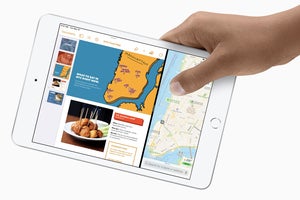The keynote at Apple's Worldwide Developers Conference may be one of the biggest events of the company's year, but it only ever scratches the surface. Not every change or update makes it into the presentation—even when it's pushing two hours, as it was this year.
As people begin to dig into the betas and watch all of the attendant technical sessions, there's a lot more that's coming to light. And while much of that information is about things happening in the here and now, or perhaps about the products that will be released in the near future, this is Apple we're talking about. The company plays the long game.
That, in turn, has encouraged those in the Apple community to start digging into the details and, of course, read the tea leaves about not only what's in the pipeline for later this year, but also what some of these changes mean for the future of Apple's device roadmap.
Reach out and touch some screen
Among the biggest bombshells from this year's keynote was the announcement that future Macs running on Apple silicon will be able to run iPhone and iPad apps unmodified. The benefit is clear: that's a huge amount of software that will be instantly available on the platform, with little to no work on the part of the developers.
But that does raise one question: what's the experience going to be like? After all, iPhone and iPad apps are primarily designed for touch, not for keyboard and cursor. (Though the new Magic Keyboard for iPad Pro has at least made it possible to use those interfaces on the iPad.) Is using one of an app designed for touch going to be satisfying on the Mac? Or will it feel like a pale simulacrum?
 Apple
Apple
iPad and iPhone apps are made for touch interfaces. What will it be like to use these apps on a Mac using Apple silicon?
On the other hand, if a Mac incorporated a touchscreen as well as a keyboard and cursor, that would certainly make such a transition easier. Apple has long sidestepped the idea of adding a touchscreen to the Mac, and from a feasibility standpoint, it seemed as though it would take big design changes on macOS for it to make sense.
Lo and behold, the upcoming Big Sur update certainly seems to evince just such a design change. Many of the widgets and controls seem to be much friendlier to the idea of touch now, especially in the menu bar, which has added surprisingly wide spacing for the items therein. And the design language between iPhone, iPad, and Mac are now more similar, potentially providing a more frictionless experience to move between. Hey, you know what would reduce that friction even more? Some sort of slick glass display you can touch...
Getting to the AR of the matter
Also largely absent in this year's keynote was a perennial favorite technology of Apple's: augmented reality. While rumors about Apple's future plans in the market have only increased, there were none of the lengthy demos of AR technology that have occupied space in previous year's events. But that's not to say that Apple hasn't been hard at work: the company rolled out ARKit 4, which contains some truly impressive technology to enable AR experiences.
 Apple
Apple
ARKit 4 made its debut at WWDC20.
Many of the major improvements in AR this year related to the ability to locate a device in space with more precision than even GPS allows. That allows for features such as placing a virtual object at a specific location in the real world, and ensuring that the viewing experience is consistent even when seen by different people on different devices. This sounds easy, but the technology it involves is remarkably complex. It also brings us one step closer to something that might make an AR device like a heads-up display more compelling.
But that's not the only hint that something big is coming from Apple: there are smaller details too. For example, a tweet by Lucas Rizzotto notes that the redesign of icons in macOS Big Sur and Siri across both the Mac and mobile platforms are now 3D and possess shadows, cues that suggest perhaps Apple is preparing its iconography for an AR experience.
One boot, two boot, red boot, dual boot
The transition to Apple silicon has also changed fundamental things about the Mac, including the boot experience. No more are there arcane keyboard shortcuts to select a boot drive, zap the PRAM, or get into recovery mode.
All of that has me wondering whether the changes could extend even further. Though Apple has steadfastly stood by not converging its product lines, might there be a loophole in there for those that want to boot an iPad into macOS or a Mac into iPadOS, say, in order to test new software on on the actual hardware?
Or, if, as suggested above, some Macs do gain a touchscreen interface, perhaps virtualizing iOS and iPadOS on the platform isn't out of the question—after all, the simulator in Xcode already provides a sort of version of that process.
It's a long shot, I admit, but with this being one of the biggest architectural shifts in Apple's history, it seems like the rule book is out the window. We've only just taken our first step into a larger world.
"device" - Google News
June 29, 2020 at 06:03PM
https://ift.tt/31xS3K1
What WWDC20 tells us about where its device roadmap is going - Macworld
"device" - Google News
https://ift.tt/2KSbrrl
https://ift.tt/2YsSbsy
Bagikan Berita Ini















0 Response to "What WWDC20 tells us about where its device roadmap is going - Macworld"
Post a Comment